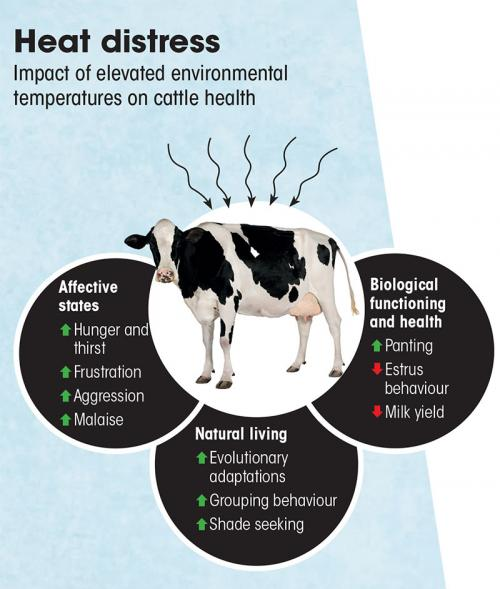Biodiversity & Environment
Climate Change and Indian Dairy Sector
- 27 Sep 2023
- 6 min read
For Prelims: Artificial Insemination, Dairy Sector, Heat Stress, Milk production
For Mains: Impact of increasing temperature and Heat Stress on Dairy Sector
Why in News?
In 2022, a study published in ‘Lancet’ estimated that increasing temperatures could reduce milk production in India’s arid and semi-arid regions by 25% by end century in 2085.
- This estimation for arid and semi-areas is the second highest in India, after Pakistan (at 28.7%). In humid and sub-humid areas, this reduction was estimated at 10%.
What is the Impact of Heat Stress on Cattles?
- Elevated temperatures affect the cow’s ability to display natural mating behaviour, as it reduces both the duration and intensity of oestrus (female animal's readiness to mate) expression.
- The decrease in conception rates during summer seasons can range between 20 and 30%, as per the study.
- Lancet Study also shows that lactating dairy cows have an increased sensitivity to heat stress compared with nonlactating (dry) cows.
- Moreover, because of the positive relationship between milk yield and heat production, higher yielding cows are more challenged by heat stress than lower yielding animals.
- The country’s milk production has been steadily increasing. However, the impact of rising temperatures, especially on cross-bred cows will make the task of meeting domestic demand difficult and could eventually lead to a decline in per capita consumption.
- The dairy sector is likely to be affected both directly and indirectly by climate change.
- Direct Impact:
- Stress to animals caused by changes in temperature-humidity index would directly affect milk production.
- Indirect Impact:
- Indirect effects include feed and water availability being impacted by adverse climate events.
- Direct Impact:
What is the Status of Milk Production in India?
- According to ‘Basic Animal Husbandry Statistics 2022, total milk production in India was 221.06 million tonnes in 2021-2022, keeping it the largest milk producing country in the world.
- The Indigenous cattle contribute 10.35% of the total milk production in the country whereas non-descript cattle contribute 9.82% and non-descript buffaloes contribute 13.49% of the total milk production in the country.
- Top five major milk producing States are Rajasthan (15.05%), Uttar Pradesh (14.93%), Madhya Pradesh (8.06%), Gujarat (7.56%) and Andhra Pradesh (6.97%).
- India’s milk production is contributing around 23% of global milk production.
What are the Issues Being Faced by Dairy Farmers?
- Issues Faced :
- Farmers allege that the government, instead of addressing the core issues, has introduced policies that further threaten to bring down milk productivity of the country.
- One such policy is sex-sorted semen production,which aims to produce only female calves up to “90% accuracy”. This has been done to enhance milk production and limit stray cattle population.
- Over the next five years, 5.1 million pregnancies will be established under the programme that offers a subsidy of Rs 750 or 50% of the cost of sex-sorted semen on assured pregnancy.
- This policy has the repercussions of overlooking and eliminating male cattle slowly.
- Growth in Female Cattle Population:
- In artificial insemination and natural service, 50% of the calves are male and 50% are female calves. Under this policy, female cattle are going to grow.
- The government has ignored that male cattle can be used in farming as an energy source.
- There is also the issue of utility of female animals after they become unproductive, because it has become difficult to sell cows due to the anti-slaughter rules across many States.
What is Artificial Insemination?
- About:
- Artificial insemination is a novel method of bringing about impregnation in female breeds.
- It prevents the spread of certain diseases which are genital in nature, thereby enhancing the efficiency of the breed.
- Shortcomings:
- Bypassing and preventing natural mating, and artificially reproducing as a principle/policy is cruel, not to mention the cruelty or pain inflicted by the artificial insemination process.
Way Forward
- Encourage research and innovation in cattle breeding and management practices to mitigate the impact of climate change.
- Promote sustainable farming practices and the use of renewable energy sources for dairy operations.
- Advocate for policies that consider the welfare of both male and female cattle.
- Explore options for the responsible management of unproductive female cattle.
- As climate change is a challenge that impacts all of us, our dairy sector must not only evolve adaptation strategies but also help in mitigation by contributing to reduction in greenhouse gas emissions from the dairy sector.
UPSC Civil Services Examination, Previous Year Question (PYQ)
Q. Consider the following statements: (2014)
- Animal Welfare Board of India is established under the Environment (Protection) Act, 1986.
- National Tiger Conservation Authority is a statutory body.
- National Ganga River Basin Authority is chaired by the Prime Minister.
Which of the statements given above is/are correct?
(a) 1 only
(b) 2 and 3 only
(c) 2 only
(d) 1, 2 and 3
Ans: (b)





